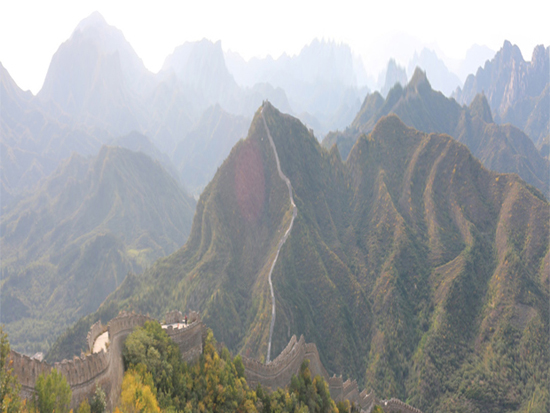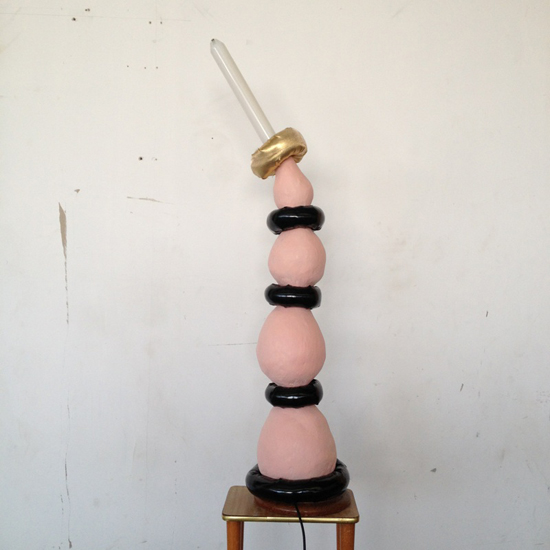From Luise Guest…
My dictionary defines the word haze as “a slight obscuration of the lower atmosphere, typically caused by fine suspended particles”. Alternatively, it means “a state of mental confusion.” Either way, it’s an apt title for an exhibition resulting from the experiences of three emerging Australian artists who undertook the inaugural 4A/Shen Shaomin studio residency in China. All three have agreed that from the richness – and confusion – of their experience of living and working in a rural village north of Beijing, the constant haze of pollution was their most significant visual memory. That grey mist which obscures the distant mountains and softens the light – beautiful but toxic – is an unforgettable feature of the Chinese landscape. ‘Haze’ features new bodies of work, produced once they had returned home, by Tully Arnot, Sarah Contos and Jensen Tjhung.
Tully Arnot, Alternative Great Wall (2013), Courtesy the artist.
I was curious to see their responses following their participation in this residency program, in which they spent September last year living and working at the studios of Shen Shaomin in the countryside outside Beijing. The word “countryside” has particular connotations for Australians, frequently shattered by an encounter with rural China, which is often far bleaker than one could imagine. Shen Shaomin’s studio is near the Great Wall in Huairou District, far from the urban grittiness and excitement of Beijing. A forbidding landscape in winter; surprisingly beautiful and leafy when I visited in spring this year. But perhaps a somewhat challenging introduction to China for young artists lucky enough to be awarded this opportunity to immerse themselves in the landscape, and to make contacts with Chinese artists and fabricators. There are many complex issues to navigate, from barriers of culture and language, to the distance from the centre of Beijing, to the pressure to make or conceive work in an unfamiliar environment.
When I met Shen at his rather brutalist self-designed complex of studio and residence buildings I asked him about the background to the residency project. In 2004, he told me, knowing that the demolition of his existing studios in the northern suburbs of Beijing was only a matter of time, he gathered together a group of friends, including other artists, film directors and architects, to buy a parcel of land. When they were eventually told they must leave their Beigao studios, and the dreaded character ? (“Demolish!”) was painted on the wall of his building, he and his friends had no choice but to move into this much more remote rural area. It took some years, but the construction was finally finished, and a new hub of art, film, and design studio spaces emerged.
“What made you want to act as a mentor for young artists, and in particular to the artists from the Australian 4A residency program?” I asked. “It started with a project in a rural village in Shanxi, a project to protect this old ancient village – ten Chinese and ten international artists. Because I was from Australia I invited some young Australian artists to participate,” Shen said. It provided those artists with an opportunity to see “the real China – not just the Great Wall and Tiananmen. So that’s where the idea came from to invite young Australian artists to China to experience real Chinese life. So far it has been very beneficial for the Australian artists – they have lots of opportunities for contact with the Chinese artists, to engage in making projects with them.” In fact, Shen told me, he wanted to give something back to Australia, feeling that, despite the difficulties of his ten years here in Sydney after 1989, something of a debt was owed. From this early beginning, the joint venture with 4A Centre for Contemporary Asian Art was developed, and Arnot, Contos and Tjhung are its first beneficiaries.
Sarah Contos, Studio documentation (2014). Courtesy the artist.
The resulting exhibition reveals both the possibilities and the difficulties of this international collaboration. The impact of China is most immediately apparent in Sarah Contos’ installation, ‘23 Ming Vases for Little Horse (everything that moves, breaks)’, a series of decorative vessels inspired by Ming Dynasty vases revered in China and the West, and sought after by collectors. Contos became interested in Ming vases as examples of how cultures are hybridised, influencing each other through borrowings and appropriations. She discovered that they are to some extent a response to Chinese trade with the Islamic world along the Silk Road. Just as blue and white “willow pattern” porcelain in Britain and Delft china in the Netherlands developed from the trade in Chinese commodities, so too did Ming Dynasty artisans borrow decorative motifs from the Arab world. Contos has used roughly applied blue and white on her vessels, underlining her references to the porcelain trade and the commodification of art and artefacts.
While some artists may have sought to visit the porcelain centre of Jingdezhen and work more literally in the material that interested them, Contos in contrast has created her vessels from plaster, calico, canvas and cardboard. They are crude, makeshift approximations created of quotidian materials – rubbish and refuse. In that sense they evoke the similarly crude and makeshift ways in which the inhabitants of Chinese villages and Beijing courtyards create temporary rooms and additions with cardboard and striped plastic bags. Beijing’s hutongs were once the homes of the imperial elite, and now often house migrant workers. They are being demolished, razed by developers who leave behind piles of bricks, dust and tattered curtains or calendars hanging askew from remaining walls. Contos is interested in this tension between traditional culture and constant change. Her installation is engaging and quirky, with its wonky lopsided forms embellished with plastic smiley faces hanging from Chinese silk knots. The absurdity of making vessels from roughly slathered plaster and throw-away materials highlights the wholesale destruction of the past which shocks every traveller in China.
Melbourne-based Jensen Tjhung creates immersive installations. He is interested in organised religion and “mixed-up beliefs from a sub-suburban realm.” His work ‘New God/False God’ positions two grotesque mannequins, slumped over, looking towards the centre of the gallery and grasping onto their plinths as if drowning. Owing something to the Chapman Brothers and something more to the popular culture genres of horror and Zombie movies, this work perhaps illustrates most clearly the challenges inherent in absorbing and transforming the possibilities afforded by a residency project in an unfamiliar culture. Tjhung questions the value (and marketability) of the art object, and the work is deliberately crudely constructed. Xu Zhen’s massive recent show at the Ullens Centre for Contemporary Art in Beijing covered some of the same contradictory territory, examining and presenting art as spectacle. It will be interesting to see where this young artist goes from here.
Tully Arnot, Nervous Plant , (2014). Courtesy the artist.
Tully Arnot has said he is interested in the “uncanny and the absurd.” He uses found objects, aiming to produce kinetic works that alter the everyday materials from which they are made, and the everyday contexts in which they are seen. ‘Cold Beer, Cold Women’ is a rope light sculpture, a response to the neon advertising seen throughout Beijing’s neighbourhoods and surrounding villages. Flickering and low-tech, I was reminded of Jin Shi’s wonderful ‘Small Business – Karaoke’ seen in the White Rabbit Gallery and the 18th Sydney Biennale. Arnot’s work, which can be read from both the front and the back and interpreted in different ways, similarly responds to the inventive and improvisational use of cheap materials by entrepreneurial Chinese eking out a precarious living on the lower levels of the commercial food chain.
It is evident that each of the three artists has been affected in important ways by their experience in China – and how could they not be? The inventive use of quotidian, throw-away materials, in particular, attests to their observation of life in the rural villages of Huairou County. The exhibition is challenging, and some works appear somewhat tentative, but there is more going on here than first meets the eye. The three artists are bound by their shared experience of being “strangers in a strange land” and the challenges of transforming that experience through the physicality of their works.




